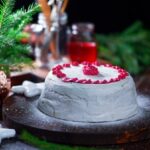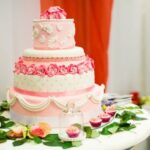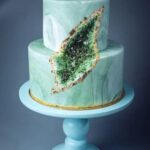Are you looking to learn how to decorate a simple cake? Whether it’s for a special occasion or just for fun, the art of cake decorating is a creative and rewarding skill to have.
In this article, we will explore the essential tools and techniques needed to transform a plain cake into a beautifully decorated masterpiece. From selecting the perfect base cake to adding finishing touches, we will guide you through the process of creating a stunning and delicious work of art.
Cake decorating may seem intimidating at first, but with the right tools and a little practice, anyone can create a beautifully decorated cake. We will discuss the essential tools and ingredients needed for simple cake decorating, as well as tips for working with frosting, icing, and piping techniques.
Whether you’re a beginner or have some experience in cake decorating, there are simple techniques that can help elevate your cakes. From using edible flowers and fruits to adding glitter and sprinkles, there are endless ways to add a personal touch to your creations. So let’s get started on your journey to becoming a skilled cake decorator.
Essential Tools and Ingredients for Simple Cake Decorating
Before you start your cake decorating journey, it’s important to make sure you have all the essential tools and ingredients on hand. Some of the basic tools you will need include a turntable for easy icing application, offset spatulas for smooth frosting, a bench scraper for creating clean edges, piping bags and tips for intricate designs, and a cake leveler for evenly layered cakes.
In addition to these tools, having a good quality stand mixer or hand mixer will make the process much easier.
When it comes to ingredients, the type of cake mix or homemade cake recipe you use as your base is crucial. It’s important to have the right consistency of cake batter that will hold its shape while being decorated.
Additionally, having a variety of food coloring gels, edible glitter, and sprinkles will allow you to add vibrant colors and decorative elements to your cake. Don’t forget about different flavors of frosting or icing – chocolate, vanilla, cream cheese – to complement your chosen base cake flavor.
As you gather your essential tools and ingredients for simple cake decorating, remember that quality is key. Investing in good equipment and using high-quality ingredients will not only make the decorating process easier but also ensure that your finished masterpiece looks impressive and tastes delicious. With the right tools and ingredients at your disposal, you’ll be well-equipped to create beautifully decorated cakes that will wow your friends and family.
Choosing the Perfect Base Cake for Decorating
When it comes to creating a beautifully decorated cake, one of the most important factors to consider is the base cake itself. A great base cake can make decorating much easier and more enjoyable. There are various options to choose from, including traditional vanilla or chocolate sponge, moist carrot cake, rich red velvet, or even a flavorful lemon or orange cake. Each type of base cake offers different options for decoration and can complement different flavors of frosting and icing.
Consider the Flavor and Texture
When choosing the perfect base cake for decorating, it’s important to consider both the flavor and texture of the cake. For example, a chocolate sponge may pair well with mocha or cream cheese frosting, while a light lemon cake could be enhanced by a tangy citrus glaze. Similarly, the texture of the cake plays an important role in how well it holds up during decorating. A sturdy base cake is essential for intricate designs and elaborate decorations.
Customizing With Fillings and Layers
Another consideration when choosing a base cake for decorating is whether you want to add fillings or create multiple layers. Filling a vanilla sponge with fresh strawberries or layering a chocolate cake with rich ganache can add an extra dimension to your decorated creation. Not only does this offer additional opportunities for flavor combinations, but it also provides visual appeal when sliced.
Considering Dietary Restrictions
In today’s diverse culinary landscape, it’s also important to consider dietary restrictions when choosing a base cake for decorating. Whether it’s opting for a gluten-free almond flour cake, a vegan chocolate sponge, or experimenting with alternative sweeteners for those watching their sugar intake, there are plenty of options available that cater to various dietary needs without compromising on taste or texture.
By carefully selecting the perfect base cake for your decorating project, you can set the stage for a stunning finished product that not only looks impressive but tastes delicious as well.
Simple Decorating Techniques for Beginners
When it comes to decorating a simple cake, there are plenty of easy techniques that beginners can try out. Whether you’re looking to create a stunning design for a special occasion or just want to add a little extra flair to a homemade treat, these simple methods can take your cake to the next level. Here are some basic decorating techniques for beginners to try:
1. Buttercream Swirls: Using a piping bag and a star-shaped tip, you can create beautiful buttercream swirls on top of your cake. Simply start from the edge and work your way towards the center, creating a spiral pattern as you go.
2. Chocolate Drizzling: Melted chocolate can be drizzled over the top of your cake for an elegant and delicious decoration. Simply heat up some chocolate in the microwave or over a double boiler, then use a spoon or piping bag to drizzle it over the cake in a decorative pattern.
3. Fondant Cutouts: Roll out some fondant and use cookie cutters or knife to create different shapes and designs. These fondant cutouts can then be placed on top of the cake for a professional-looking finish.
These simple decorating techniques are perfect for beginners who want to add a creative touch to their cakes without feeling overwhelmed by more advanced methods. With practice and patience, you’ll be able to master these basic techniques and move on to more complex designs in no time.
Adding a Personal Touch With Edible Flowers and Fruits
Adding edible flowers and fruits to your decorated cake is a great way to add a personal touch and elevate the overall aesthetic of your creation. Not only do they provide a pop of color, but they also bring a fresh and natural element to the dessert.
Some popular edible flowers that are often used for cake decorating include roses, pansies, violets, and lavender. When it comes to fruits, berries are a common choice due to their vibrant hues and sweet taste.
When incorporating edible flowers and fruits into your cake design, it’s important to ensure that they are safe for consumption and have not been treated with any harmful chemicals. You can purchase these items from specialty food stores or farmers’ markets where they are specifically labeled as “edible.” Alternatively, if you have access to organic flowers and fruits from your own garden or a trusted source, those would be ideal for decorating purposes.
For best results, gently wash the edible flowers and fruits with water before adding them to your cake. This will remove any potential dirt or debris while maintaining their freshness. Keep in mind that delicate flowers should be added to the cake shortly before serving to prevent wilting or browning. As for fruits, consider the moisture content and how it may impact the texture of the frosting or cake over time.
| Edible Flowers | Popular Fruits |
|---|---|
| Roses | Strawberries |
| Pansies | Blueberries |
| Violets | Raspberries |
| Lavender | Blackberries |
Tips for Working With Frosting and Icing
When it comes to cake decorating, working with frosting and icing is a crucial skill to master. The right texture and consistency of your frosting can make or break the overall look of your decorated cake. Read on for some tips on how to work with frosting and icing to achieve a professional-looking finish.
Choosing the Right Frosting
There are various types of frosting and icing, each with its own unique characteristics. Buttercream, fondant, cream cheese frosting, and royal icing are just a few examples. When choosing the right frosting for your cake, consider the flavor profile, texture, and design you have in mind. For beginners, buttercream is often a good choice as it is easy to work with and can be flavored and colored in countless ways.
Consistency Is Key
No matter what type of frosting or icing you choose, achieving the right consistency is essential. If your frosting is too runny, it will not hold its shape when piped onto the cake.
On the other hand, if it’s too stiff, it will be difficult to work with and may result in uneven or lumpy designs. Practice adjusting the consistency of your frosting by adding small amounts of liquid (such as milk or cream) or sugar until you reach the desired texture.
Techniques for Smooth Icing
To achieve a smooth finish when icing a cake, start by applying a thin layer of frosting (also known as a crumb coat) and refrigerating the cake for 15-20 minutes before adding another layer of frosting. This will help seal in any loose crumbs and create a clean base for your final design.
Use an offset spatula to apply an even layer of frosting around the sides and top of the cake, then use a bench scraper to smooth out any imperfections for a polished look.
With these tips in mind, you’ll be well-equipped to work with different types of frostings and icings to beautifully decorate your cakes. Mastering this skill will take practice, but with patience and creativity, you can create stunning designs that will impress your family and friends alike.
Using Piping Techniques to Create Beautiful Designs
Piping techniques are a great way to add intricate and stunning designs to your simple cake. With just a few basic tools and some practice, you can create professional-looking decorations that will impress any crowd.
One of the most popular piping techniques is the use of a pastry bag fitted with various tips to create different patterns and designs. From rosettes to shells to leaves, the possibilities are endless when it comes to piping designs on your cake. With practice, you can even create more advanced designs such as intricate lace patterns or floral arrangements.
To get started with piping, it’s important to have the right consistency of frosting or icing. If the mixture is too stiff, it will be difficult to pipe; if it’s too runny, the design won’t hold its shape. Additionally, practicing on a flat surface before moving onto the cake can help you get a feel for how much pressure is needed to create different shapes and patterns.
Finally, don’t be afraid to experiment with colors and textures when using piping techniques. You can use different colored frostings or even mix in edible glitter or sprinkles to add some extra flair to your designs. The key is to have fun and let your creativity shine through in your decorated masterpiece.
| Piping Technique | Description |
|---|---|
| Rosettes | A circular pattern resembling a rose, created by applying pressure while swirling the pastry bag. |
| Shells | An overlapping pattern resembling seashells, created by piping a wavy line and then pulling back into itself. |
| Leaves | A teardrop-shaped design resembling leaves, created by applying pressure and then pulling away at an angle. |
Adding the Finishing Touches to Your Decorated Cake
The finishing touches on a decorated cake can take it from average to stunning. Adding sprinkles, glitter, or other decorative items can elevate your simple cake into a work of art. Here are some ideas for adding the perfect finishing touches to your decorated cake:
- Sprinkles: Sprinkles are an easy way to add color and fun to your cake. Whether you choose rainbow sprinkles, chocolate jimmies, or metallic dragees, sprinkles can make your cake visually appealing.
- Glitter: Edible glitter can add a touch of glamour to your cake. You can use edible glitter in a single color or create a dazzling ombre effect by using different shades.
- Edible flowers and fruits: Fresh fruits and edible flowers not only add beauty to your cake but also provide a pop of natural flavor. Berries, citrus slices, and blooms like roses or pansies can bring elegance and freshness to your cake.
Adding these finishing touches can turn your simple cake into a showstopper at any event. When using decorative items like sprinkles and glitter, be sure to sprinkle them evenly for a polished look. With edible flowers and fruits, strategically placing them around the cake will enhance its overall appearance.
Remember that less is often more when it comes to adding finishing touches to cakes. Be mindful not to overwhelm the design with too many elements. Experiment with different combinations to find the perfect balance for your decorated masterpiece.
Conclusion
In conclusion, decorating a simple cake can be a fun and creative way to showcase your baking skills. Whether you are a beginner or have some experience with cake decorating, the key is to start with the right tools and ingredients. By choosing the perfect base cake and learning some simple decorating techniques, you can create a beautifully decorated masterpiece that will impress your friends and family.
Adding a personal touch to your cake with edible flowers and fruits can elevate its visual appeal and add a delicious flavor profile. Working with frosting and icing can be challenging, but with practice and the right tips, you can achieve smooth and professional-looking results. Piping techniques also offer endless possibilities for creating beautiful designs, giving your cake that “wow” factor.
Finally, don’t forget to add the finishing touches to your decorated cake, such as sprinkles or edible glitter, to really make it stand out. Showcasing your decorated masterpiece is an important part of the process – take photos to share on social media or at gatherings, and don’t be afraid to ask for feedback.
Remember that improvement comes with practice, so keep experimenting with new techniques and designs to further enhance your cake decorating skills. With time and dedication, you’ll be creating stunning works of edible art in no time.

Welcome to my blog about home and family. This blog is a place where I will share my thoughts, ideas, and experiences related to these important topics. I am a stay-at-home mom with two young children. I hope you enjoy reading it! and may find some helpful tips and ideas that will make your home and family life even better!





